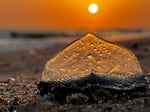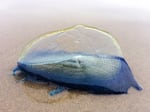
One of thousands of creatures known as "by-the-wind sailors" that have been washing ashore on Southern California beaches in April.
Allen J. Schaben / Los Angeles Times via Getty Images
The Velella velella, a name so nice you gotta say it twice.
Who are they? The tiny disc-like critters are colonial hydrozoans, classified under the phylum of cnidaria, and their eponymous genus of Velella (not a Game of Thrones reference).
Meet Vellela vellela, or By-the-wind-sailor!
— CAStateParksOC (@CAStateParksOC) April 10, 2023
These have been washing ashore #CrystalCove lately.
They are related to #seajellies but are not #jellyfish themselves. They are #hydroids w/ stinging #tentacles they use to paralyze #plankton for food. Notice their “sails” up top. pic.twitter.com/cO0HftuNxr
What's the big deal? California beachgoers have reported seeing thousands of the Velella velella along the shoreline recently, though they typically live far offshore.
Want more on oceans? Listen to the Consider This episode on why melting ice in Antarctica is a big problem for coastal Texas.

The velella velella sitting on sand after washing up on shore.
Autum Sasala / Getty Images
What are people saying? Marine biologist Julianne Kalman Passarelli is the education and collections curator at Cabrillo Marine Aquarium in San Pedro, California, and spoke with NPR about the mysterious blobby dudes.
On how they reproduce:
Hydrozoans are just really bizarre because they do something called alternation of generations. That's how they reproduce. And they go back and forth between a polyp stage, a colonial polyp stage, and a medusa stage.
On the structure of the Velella velella and its ecosystem:
[The Velella velella is] a colony of animals. And if you look really closely, all those little things hanging down that look like tentacles are all different organisms within the same colony, and they all work together, kind of like coral, and they all have a different purpose. One is for reproduction, one is for feeding, and one is for defense.
On the textures of the sail:
If you were to touch the top of the sail, it feels like plastic. It's quite thick. And actually what's in there is chitin. And that's the same material that is in the exoskeleton of crustaceans. So it's notoriously hard and protective, but you definitely don't want to pick them up and touch them because they are cnidarians. Their sting is not known to be as toxic as their relatives, the Portuguese man o' war, or even their more distant relatives jellyfish, sea nettles, things like that. But they can cause irritation. I wouldn't suggest picking them up with your bare hands.
I thought these were rocks but it’s the By-the-Wind Sailor or Velellas’again! So many all down the beach! #Bythewindsailor #ktla #FoxNews #news pic.twitter.com/0r8Wtzbxye
— Michele Steer (@Michsteer) April 13, 2023
So, what now?
Learn more:
Copyright 2023 NPR. To see more, visit https://www.npr.org.